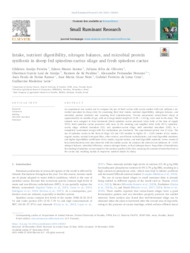Intake, nutrient digestibility, nitrogen balance, and microbial protein synthesis in sheep fed spineless-cactus silage and fresh spineless cactus.
Intake, nutrient digestibility, nitrogen balance, and microbial protein synthesis in sheep fed spineless-cactus silage and fresh spineless cactus.
Author(s): PEREIRA, G. A.; SANTOS, E. M.; OLIVEIRA, J. S. de; ARAUJO, G. G. L. de; PAULINO, R. de S.; PERAZZO, A. F.; RAMOS, J. P. de F.; CÉSAR NETO, J. M.; CEUZ, G. F. de L.; LEITE, G. M.
Summary: An experiment was carried out to compare the use of fresh cactus with cactus ensiled with and without a microbial inoculant in sheep diets by examining their feed intake, nutrient digestibility, nitrogen balance, and microbial protein synthesis and counting fecal enterobacteria. Twenty uncastrated mixed-breed sheep at approximately six months of age, with an average initial weight of 23.48 ± 2.40 kg, were used in the study. The animals were assigned to four treatments [fresh spineless cactus processed twice daily at the time of supply (FC2); fresh spineless cactus processed only once, in the morning, and supplied twice daily (FC1); spinelesscactus silage without inoculant (CS); and spineless-cactus silage with microbial inoculant (CSI)] in a completely randomized design with five replications per treatment. The experimental period was 21 days. The use of spineless cactus in the form of silage (CS and CSI) resulted in higher (P < 0.05) intakes of dry matter, organic matter, neutral detergent fiber, ether extract, non-fibrous carbohydrates, and total digestible nutrients; and higher digestibility coefficients of dry matter, organic matter, and total digestible nutrients. Lower counts of fecal enterobacteria were also observed with the ensiled cactus. By contrast, the diets did not influence (P> 0.05) nitrogen balance, microbial efficiency, urinary nitrogen losses, or fecal nitrogen losses. Regardless of inoculation, the ensiling of spineless cactus improves the sanitary quality of the diet, reducing the amount of enterobacteria in the cactus and resulting mainly in improved nutrient intake by sheep.
Publication year: 2021
Types of publication: Journal article
Unit: Embrapa Semi-arid Region
Observation
Some of Embrapa's publications are published as ePub files. To read them, use or download one of the following free software options to your computer or mobile device. Android: Google Play Books; IOS: iBooks; Windows and Linux: Calibre.
Access other publications
Access the Agricultural Research Database (BDPA) to consult Embrapa's full library collection and records.
Visit Embrapa Bookstore to purchase books and other publications sold by Embrapa.

